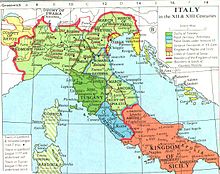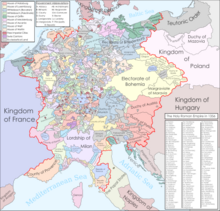Kingdom of Italy (Holy Roman Empire)
Kingdom of Italy | |||||||||||
|---|---|---|---|---|---|---|---|---|---|---|---|
| 855–1801 | |||||||||||
Otto I | |||||||||||
• 1519–1556 | Charles V1 | ||||||||||
Arch-Chancellor2 | |||||||||||
• 962–965 (first) | Bruno of Lotharingia | ||||||||||
• 1784–1801 (last) | Maximilian Francis of Austria | ||||||||||
| Historical era |
| ||||||||||
| 1075–1122 | |||||||||||
| 1158 | |||||||||||
| 1216–1392[1] | |||||||||||
| 1494–1559 | |||||||||||
| 9 February 1801 | |||||||||||
| ISO 3166 code | IT | ||||||||||
| |||||||||||
| Today part of | Italy | ||||||||||
| |||||||||||
| History of Italy |
|---|
 |
|
|
The Kingdom of Italy (
In 773,
In 951, King
The century between the
After the
The Habsburg rule in several parts of Italy continued in various forms but came to an end with the campaigns of the French Revolutionaries in 1792–1797, when a series of sister republics were set up with local support by Napoleon and then united into the Italian Republic under his presidency. In 1805 the Italian Republic became the Kingdom of Italy with Napoleon as the new king. This state was disbanded with the collapse of Napoleonic rule in 1814.
Lombard Kingdom
After the
The Kings of the
The primary sources for the Lombard kings before the Frankish conquest are the anonymous 7th-century
The actual control of the sovereigns of both the major areas that constitute the kingdom –
The Lombard kingdom proved to be more stable than its Ostrogothic predecessor, but in 774, on the pretext of defending the
Constituent of the Carolingian Empire
The death of the Emperor
Following Louis II's death without heirs, there were several decades of confusion. The
In the 10th century, the situation hardly improved, as various Burgundian and local noblemen continued to dispute over the crown. Order was only imposed from outside, when the German king
Imperial Italy
In 951, King
In general, the monarch was an absentee, spending most of his time in Germany and leaving the Kingdom of Italy with little central authority. There was also a lack of powerful landed magnates – the only notable one being the
Henry's Salian successor Conrad II tried to confirm his dominion against Archbishop Aribert of Milan and other Italian aristocrats (seniores). While besieging Milan in 1037, he issued the Constitutio de feudis in order to secure the support of the vasvassores petty gentry, whose fiefs he declared hereditary. While Conrad stabilised his rule, however, the Imperial supremacy in Italy remained contested.
Staufer

The cities first demonstrated their increasing power during the reign of the Hohenstaufen Emperor Frederick Barbarossa (1152–1190), whose attempts to restore imperial authority in the peninsula led to a series of wars with the Lombard League, a league of northern Italian cities, most of the times headed by Milan, and ultimately to a decisive victory for the League at the Battle of Legnano in 1176, that had as its leader the Milanese Guido da Landriano, which forced Frederick to make administrative, political, and judicial concessions to the municipalities, officially ending his attempt to dominate Northern Italy. From then, Italy became a patchwork of autonomous duchies and city-states only nominally tied to the Holy Roman Empire.[13][14]

The scene was similar to that which had occurred between
Frederick's son Henry VI actually managed to extend Hohenstaufen authority in Italy by his conquest of the Norman Kingdom of Sicily, which comprised Sicily and all of Southern Italy. Henry's son, Frederick II, Holy Roman Emperor – the first emperor since the 10th century to actually base himself in Italy – attempted to return to his father's task of restoring imperial authority in the northern Italian Kingdom, which led to fierce opposition not only from a reformed Lombard League, but also from the Popes, who had become increasingly jealous of their temporal realm in central Italy (theoretically a part of the Empire), and concerned about the hegemonic ambitions of the Hohenstaufen emperors.
Frederick II's efforts to bring all of Italy under his control failed as signally as those of his grandfather, and his death in 1250 marked the effective end of the Kingdom of Italy as a genuine political unit. Conflict continued between
Decline

The Italian campaigns of the Holy Roman emperors decreased, but the kingdom did not become wholly meaningless. In 1310 the
Successive emperors in the 14th and 15th centuries were bound in the struggle between the rivaling Luxembourg, Habsburg and Wittelsbach dynasties. In the conflict with Frederick the Fair, King Louis IV (reigned until 1347) had himself crowned emperor in Rome by Antipope Nicholas V in 1328. His successor Charles IV also returned to Rome to be crowned in 1355. None of the emperors forgot their theoretical claims to dominion as kings of Italy. Nor did the Italians themselves forget the claims of the emperors to universal dominion: writers like Dante Alighieri (died 1321) and Marsilius of Padua (c. 1275 – c. 1342) expressed their commitment both to the principle of universal monarchy, and to the actual pretensions of Emperors Henry VII and Louis IV, respectively.
The Imperial claims to dominion in Italy mostly manifested themselves, however, in the granting of titles to the various strongmen who had begun to establish their control over the formerly republican cities. Most notably, the emperors gave their backing to the
Imperial fiefs in the modern period
By the beginning of the early modern period, the Kingdom of Italy still formally existed but had de facto splintered into completely independent and self-governing Italian city-states. Its territory had been significantly limited – the conquests of the Republic of Venice in the "domini di Terraferma" and those of the Papal States had taken most of northeastern and central Italy outside the jurisdiction of the Empire.[19]
In many aspects, the Imperial claims to feudal overlordship over the Italian territories had become practically meaningless: the effective political authority, as well as the power to raise taxes and spend resources, was in the hands of the Italian princes and dukes. However, the presence of the Imperial feudal network in Italy continued to play a role in the history of the peninsula. It gave to Emperors
In 1559, the Kingdom of France ended its ambitions over the Imperial fiefs in Italy, abandoning its claims to Savoy and Milan and withdrawing from Tuscany and Genoese Corsica by the terms of the Treaty of Cateau-Cambrésis. The major imperial fiefs in Italy were known as "Feuda latina", whereas the smaller ones were known as "Feuda Minora". Italian princes did not send representatives to the Imperial Diet, but their forces also joined the Imperial Army, as in the case of the Hungarian campaign of Maximilian II against Suleiman the Magnificent in 1566.[22]
While they were excluded from the Reichstag, the Italian states were still considered vassals of the emperor, like other states of the empire, and thus subject to certain obligations and jurisdiction. A special Italian section of the
Imperial authority was used by the Austrian Habsburgs to intervene in Italy during the
Emperor Leopold I increasingly asserted his rights over the imperial fiefdoms of Italy from the 1660s with the decline of Spanish power and more overt intervention of the French. In 1687, a new plenipotentiary of Italy was appointed, a position that had been left vacant for over a century prior (the powers of the office had instead been exercised haphazardly by the Aulic Council). In 1690,
Dissolution
The status of Imperial Italy was more or less stable up to 1789. There was even a serious push by the Savoyards (backed by Prussia) to raise Savoy to electorate status in 1788, which would make it only the second non-German state to become so (after Bohemia, which was after the crushing of Bohemian estates in 1620 dominated by German-speaking aristocrats). This came to nothing as the French Revolution of 1789 would quickly shatter the old order.[30]
During the
See also
Notes
- ^ Jaques, Tony. Dictionary of Battles and Sieges: A-E.
- ^ Lodovico Antonio Muratori; Giuseppe Oggeri Vincenti (1788). Annali d'Italia. pp. 78–81.
- ^ "Ottone I di Sassonia" (in Italian). Retrieved 26 August 2023.
- ^ Taddei, Elena. "Reichsitalien" in Mittelalter und Neuzeit/"Feudi imperiali italiani" nel Medioevo e nell'Età Moderna. StudienVerlag.
- ^ De Bello Gothico IV 32, pp. 241-245
- ^ the Deacon, Paul. History of the Lombards (The Middle Ages Series). University of Pennsylvania Press.
- ^ Deanesly, Margaret. A History of Early Medieval Europe From 476 to 911. Methuen & Co.
- ^ "DESIDERIO, re dei Longobardi" (in Italian). Retrieved 26 August 2023.
- ^ "Ottóne I il Grande imperatore e re di Germania" (in Italian). Retrieved 26 August 2023.
- ^ Tabacco, Giovanni. The Struggle for Power in Medieval Italy: Structures of Political Rule. Cambridge University Press. p. 116.
- ^ Orioli, R. Fra Dolcino. Nascita, vita e morte di un'eresia medievale. Jaca Book. p. 233.
- ^ "Battaglia di Solferino e San Martino" (in Italian). Retrieved 26 August 2023.
- ^ "La battaglia di Legnano". Ars Bellica. Retrieved 2020-07-09.
- ^ Grillo, Paolo. Legnano 1176. Una battaglia per la libertà (in Italian). Laterza. pp. 157–160.
- ^ Comyn (1851), p. 260
- ^ See Yale Avalon project.
- ^ Le Goff (2000), pp. 96–97
- ^ "Enrico VII di Lussemburgo imperatore" (in Italian). Retrieved 26 August 2023.
- ^ "The Rise & Alliance of the Italian City-States". study.com. Retrieved 2020-10-13.
- ^ Maltby, William. The Reign of Charles V (European History in Perspective). Palgrave; 2002 edition.
- ^ "Charles V | Biography, Reign, Abdication, & Facts". Encyclopedia Britannica. Retrieved 2020-07-09.
- ^ Ludovico Muratori, "Annali d'Italia", Anno Domini 1566, mentioned in Brendian Maurice Dooley, Italy in the Baroque – Selected readings, New York and London 1995, pp. 622–628 and p. 678.
- ISBN 978-88-6576-606-4.
- ISBN 978-88-6576-606-4.
- ^ Wilson 2016, p. 226.
- ^ Wilson 2016, p. 226-227, p. 749.
- ^ Joachim Whaley, "Germany and the Holy Roman Empire: Volume II: The Peace of Westphalia to the Dissolution of the Reich, 1648-1806", from the Oxford History of Early Modern Europe, p. 109-110, 24.
- ^ Whaley, p. 137.
- ^ Whaley, p. 76.
- ^ Wilson 2016, p. 227.
- ^ "Treaty of Campo Formio | France-Austria [1797]". Encyclopedia Britannica. Retrieved 2020-07-09.
- ^ H. Thompson, Richard. Lothar Franz Von Schonborn and the Diplomacy of the Electorate of Mainz: From the Treaty of Ryswick to the Outbreak of the War of the Spanish Succession. Springer. pp. 158–160.
- ^ Palmer, R. R. A History of the Modern World. McGraw-Hill Education.
- ISBN 9780025236608.
- S2CID 154316830.
References
- Liutprand, Antapodoseos sive rerum per Europam gestarum libri VI.
- Liutprand, Liber de rebus gestis Ottonis imperatoris.
- Anonymous, Panegyricus Berengarii imperatoris (10th century) [Mon.Germ.Hist., Script., V, p. 196].
- Anonymous, Widonis regis electio [Mon.Germ.Hist., Script., III, p. 554].
- Anonymous, Gesta Berengarii imperatoris [ed. Dumueler, Halle 1871].
- Peter Wilson. "Heart of Europe: A History of the Holy Roman Empire." Cambridge: 2016.
- Comyn, Robert (1851). History of the Western Empire, from its Restoration by Charlemagne to the Accession of Charles V. Vol. I.
- Le Goff, J. (2000). Medieval Civilization, 400–1500. New York: Barnes and Noble.


